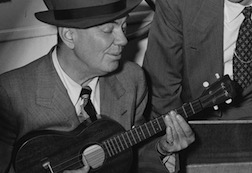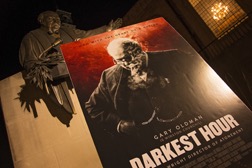What's In A Name?
November 2018
Bridges To The Past And Future
August 2018

But I couldn’t take my eyes off the steel road for long, because this old bridge, like most of its sisters, requires nerve and skill and keen attention to avoid a sideswiping succession of 18-wheelers coming at us like they’re pumped from a pitching machine. Most of this bridge’s old river sisters have been replaced by wider, safer spans. Soon this ninety-year-old sister will retire, too.
From Washington, Highway 100 stretches toward Hermann like a clothesline, draping over bluffs and peeking down ravines at your road’s companion, the Missouri River. The river was the major highway when John Colter traveled upstream with Lewis and Clark. Later, Colter settled on a farm near what became New Haven. The town sits undisturbed by our plastic fast-food culture. Even mighty Amtrak doesn’t slow down as it splits the town in half, shaking windows with the blast of its fearsome whistlehorn when it barrels past.
The John Colter Memorial is the town’s centerpiece. Or maybe the centerpiece is the pair of museums, or the old Central Hotel Bed and Breakfast. But for me the town’s centerpiece is the art-deco ambiance of the Walt Theatre, an eighty-year-old movie house refurbished to its 1940s glory, with the original towering movie marquee dressed in neon. In a life-imitates-art moment, the marquee displayed one word: Sing. It’s an animated movie: “a Koala named Buster Moon has one final chance to restore his theatre to its former glory by producing the world’s greatest singing competition.”
Picking a sure bet for lunch, Erifnus parked in front of El Ranchito Mexican Restaurant, and I put another notch in my bandolier, maybe my 500th Mexican restaurant. Maybe more.
As we pulled out of the parking space and headed to the end of the street to cross the tracks, Amtrak’s Missouri River Runner bore down on the intersection. The crossing guard arm started to come down. I thought about trying to beat the train. Erifnus is old, and it wasn’t fair to turn her into scrap metal after a historic run. Worse, if we failed, the engineer and conductor and passengers would sustain injury from the impact and suffer post-traumatic distress. They would be delayed while emergency personnel cleared the wreck and packed my bloody body parts into a bag.
We waited for the train to pass, and we lost 20 seconds we’ll never get back.
John Robinson’s new book, “Souls Along The Road,” is available this fall.
That Famous Hannibal Voice
May 2018

Next time you sit down with the kids to watch Disney’s Pinocchio, listen to the cricket. He was born here. At least, his voice was born here. When that loveable bug sings “When You Wish Upon a Star,” the voice of Jiminy Cricket is a Hannibalian named Cliff Edwards.
Never heard of him?
One fan believes a curtain call is long overdue for Mr. Edwards. Stephen Andsager isn’t from Hannibal. He’s from Columbia. But Steve has something in common with Edwards: They’re troubadours whose instrument is a ukulele.
Steve stays busy as a bandleader, dusting off tasty ballads and toe tappers from America’s obscure musical archives. Years ago I played with Steve in the Mudbugs, a band with a honky swamp swing style and a sidebar campaign to make the mudbug (crawfish) the state crustacean. The Missouri legislature didn’t share our zeal.

You’ve heard his voice as a dying Confederate soldier in Gone with the Wind. You’ve heard him sing “When I See an Elephant Fly” in Dumbo. His hit records include “California Here I Come,” “It’s Only a Paper Moon,” and “Singin’ in the Rain,” which was a chart-topper before the Gene Kelly movie.
Clifton Avon Edwards was born in Hannibal in 1895. He later moved to St. Louis and St. Charles, and eventually Hollywood. He was a fixture on the vaudeville circuit, and the Ziegfield Follies. He appeared in movies starring Buster Keaton, Joan Crawford and Tim Conway. Along the way, he became Ukulele Ike, and appeared on The Mickey Mouse Club.
“He should be in the Hall of Famous Missourians,” Steve told me the other day.
“Good luck with that,” I cautioned him. One person— the Missouri Speaker of the House—picks inductees into the Missouri Capitol’s Hall of Famous Missourians. The waiting list is long.
But Steve makes a compelling case. “Who is the King of Rock ‘n’ Roll?” he asks. “That’s easy: Elvis. But who is the King of Ukulele?”
Not Tiny Tim. Not Don Ho or Arthur Godfrey. It’s Ukulele Ike.
“His achievements include nine Broadway productions,” Steve said. “He had his own radio and TV shows. He sold 74 million records and performed in more than 100 films.
“Long before the guitar was the must-have instrument, all the cool kids played ukulele,” Steve said. “Just about everyone knows someone who plays a uke these days, but the instrument’s first wave of popularity began before World War II. Ukulele Ike was the inspiration for millions of budding musicians.
“Despite his career success,” Steve told me, “Cliff’s personal life was problematic. Like most entertainers, his brand went out of style and the popular culture of the ‘60s left him behind. He died penniless in a nursing home with no family and no one to claim his body.
“Ukuleles are everywhere lately,” Steve said. “But nowhere is there a memorial for Ukulele Ike. He was a great American entertainer who lacks the recognition he deserves. At the very least, there should be a memorial bust in his birthplace of Hannibal.”
There are traces of Ukulele Ike in Hannibal. You can find his story in the Hannibal Museum downtown. But no statue. Underappreciating Ike can be forgiven of a town so immersed in Mark Twain.
But when you wish upon a star, what do you sing?
John Robinson is the author of two books and is working on a third.
A Light In The Dark
February 2018

Strong bonds connect William Shakespeare to Missouri.
A self-styled Shakespearean actor, Frank James quoted the Bard during a train robbery at Gads Hill, Missouri. The well-read James may have favored a scene in Henry IV Part I—featuring the fat-kidneyed Falstaff and a gang of highwaymen on the Road by Gads Hill—because it fit Frank’s disdain for fusty fat cats who rode the rails.
Across the pond from Hamlet’s Elsinore, one of Missouri’s central characters trod the boards in a life worthy of Shakespeare. Mel Carnahan, born in Ellsinore, Missouri, became governor until his untimely death in a plane crash, which also killed his son, Randy, and his chief aide Chris Sifford.
Shakespeare would have loved to create the character Winston Churchill, whose speech on the campus of Fulton’s Westminster College set in motion the American visual of the cold war, which consumed the attention of an octet of presidents, including Ronald Reagan, who starred in King’s Row, an Oscar-nominated movie loosely based on Fulton characters.
Recently Oscar buzz filled the air at Fulton’s Church of St. Mary the Virgin, Aldermanbury, dressed up to host the red carpet debut of “Darkest Hour,” an intimate peek into Winston Churchill’s mind as he faced the menace of Adolf Hitler’s Nazi aggression.
The film is a tour de force by actor Gary Oldman as Churchill, a riveting study of the many sides of Churchill, and the camera rarely strays from him as he transforms from a doubt-ridden has-been into Britain’s leader against tyranny, repeating the now-familiar mantra, “Never give up.”
This personal glimpse of Churchill by director Joe Wright is not an action adventure film. Star Wars junkies may squirm in their seats, hoping for more pyrotechnics. But it’s a good thing Oldman didn’t squirm during his hours in the makeup chair, transforming him into one of the greatest historical figures of any time. Oldman captures Churchill’s deeply conflicting moods during Britain’s struggle with its own resolve at the beginning of the war. Oldman becomes Churchill: his depression, his humor, his voice and mannerisms as he spars with Parliament, King George V and his own family while wrestling with the impending catastrophe at Dunkirk.
Like a fine wine, this movie pairs well with Dunkirk, the movie about England’s dramatic civilian armada that braved the English Channel to rescue 300,000 British soldiers from certain death at the hands of Hitler. It’s interesting that both movies came out within months of each other.
The Museum
The old church was built nearly 900 years ago in the middle of London. Sir Christopher Wren redesigned the chapel after the 1666 Great Fire of London gutted its interior. The blitzkriegs of 1941 damaged the old church again. But it survived enough that in the mother of all pilgrimages, loving hands picked up the church, stone by stone, jumped the pond and plopped it down in Fulton.
That story, itself, deserves acclaim. Churchill had visited Fulton’s Westminster College in 1946, and delivered a speech titled “Sinews of Peace,” better remembered as the Iron Curtain speech. In a bold move to forever link Churchill and Fulton, Westminster College in the early-1960s “settled on the rather more ambitious notion of moving a Christopher Wren designed Church from London,” according to museum officials.
Beneath the church is the National Churchill Museum which, “through the imaginative and innovative use of technology, brings to life the story of Winston Churchill and the world he knew.” This collection of fascinating displays and artifacts, along with its programs and events, was formally designated by Congress as America’s National Churchill Museum.
Before the old church made its big leap, before the tragic fire and the awful bombs, this was the church where William Shakespeare prayed for good reviews.
Darkest Hour is a plot worthy of Shakespeare. And the movie and museum are worthy of your time.
John Robinson is the author of two books and is working on a third, “300001, A Road Odyssey.”
